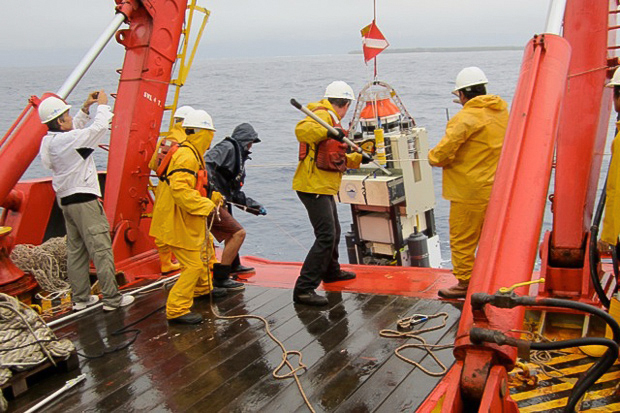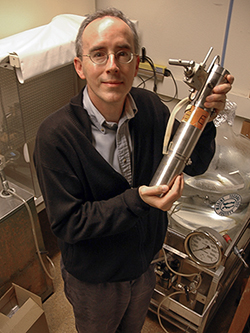
By:
- Mario Aguilera
Published Date
By:
- Mario Aguilera
Share This:
Scripps Delivers Science to James Cameron’s Historic Dive into the Abyss
Voyage to world’s deepest point offers tantalizing research opportunities for Scripps scientists

As part of James Cameron's "Deepsea Challenge," Scripps engineer Kevin Hardy (center, with hook) deploys a deep ocean vehicle (DOV), or "lander" that he developed to explore the mysteries of the world's deepest points.
When filmmaker James Cameron recently reached the depths of the Mariana Trench, the deepest spot in the world, the historic event culminated nearly a decade of interaction with Scripps Institution of Oceanography at UC San Diego.
With Scripps scientist Doug Bartlett and engineer Kevin Hardy there to support Cameron’s international headline-grabbing “Deepsea Challenge,” the project achieved much more than a one-time record-breaking plunge into the deepest abyss. As the project’s primary science collaborator, Scripps, and in turn science, stand to gain much from the collaboration.

Scripps marine microbiologist Doug Bartlett.
“The Deepsea Challenge expedition is highlighting in stunning and dramatic fashion the alien-like environments that exist at great depth,” said Bartlett, a Scripps marine microbiologist and chief scientist of the voyage. “Hadal (existing at depths greater than 20,000 feet) life forms are the part of the earth's biology that are least understood.”
Inside Deepsea Challenger, a specially designed submersible, Cameron descended 35,756 feet (6.77 miles) in two hours and 36 minutes to become the first solo diver in history to reach the Pacific Ocean’s “Challenger Deep.”
With samples and extractions from the Mariana Trench, a location where one of the planet’s massive tectonic plates is moving under, or “subducting,” another, Bartlett hopes to gain insight into how organisms thrive in the extremes of a punishing environment.
“The dark, high pressure, low temperature, and altered nutrient conditions of deep-sea environments have influenced the evolution and distribution of life in profound ways that we have yet to fully discern,” said Bartlett. “We now have the tools and technology, manned and unmanned, for in-depth studies of deep life for the benefit of basic and applied science.”
Scripps’ history in exploring the deepest regions of the ocean go back to the 1950s and ’60s, when Scripps research geologist Robert Fisher meticulously mapped the Mariana Trench’s deepest points. He employed innovative sounding techniques to firmly establish that Challenger Deep in the Mariana Trench is the deepest point in the world’s oceans. In 1952, Fisher identified Horizon Deep in the Tonga Trench as the second-deepest point in the oceans and the deepest spot in the Southern Hemisphere.
This work set the stage for Swiss oceanographer Jacques Piccard and U.S. Navy Lieutenant Don Walsh’s famous dive aboard the bathyscaphe Trieste in the first manned voyage to the bottom of Challenger Deep on January 23, 1960.
“We really haven’t had access to these areas of the deep ocean, so (Cameron) has provided the opportunity to push the technology forward,” said Hardy, who has developed new instruments to explore the deep sea (see sidebar), in a recent television interview. Hardy’s instruments must be rigorous enough to withstand the deep’s extremes, such as immense pressure forces. “It’s like taking a 200-pound man and supporting him on two toothpicks.”
Hardy joined the Cameron expedition to fulfill a lifelong dream of reaching the world’s deepest point.
“If you go somewhere no one else has been,” he said, “you will find things no one else has seen.”
Learn more about Scripps Oceanography’s DOV landers
Share This:
You May Also Like
Stay in the Know
Keep up with all the latest from UC San Diego. Subscribe to the newsletter today.


